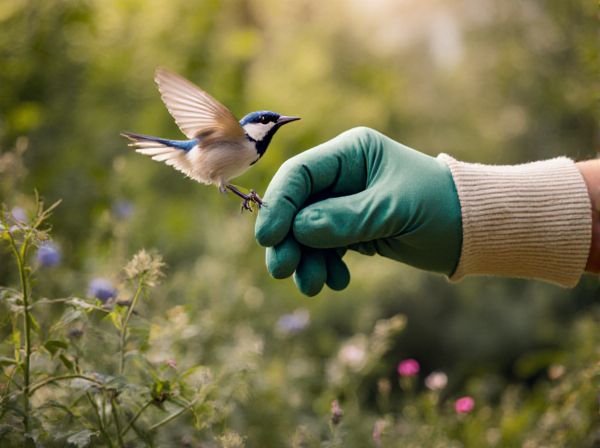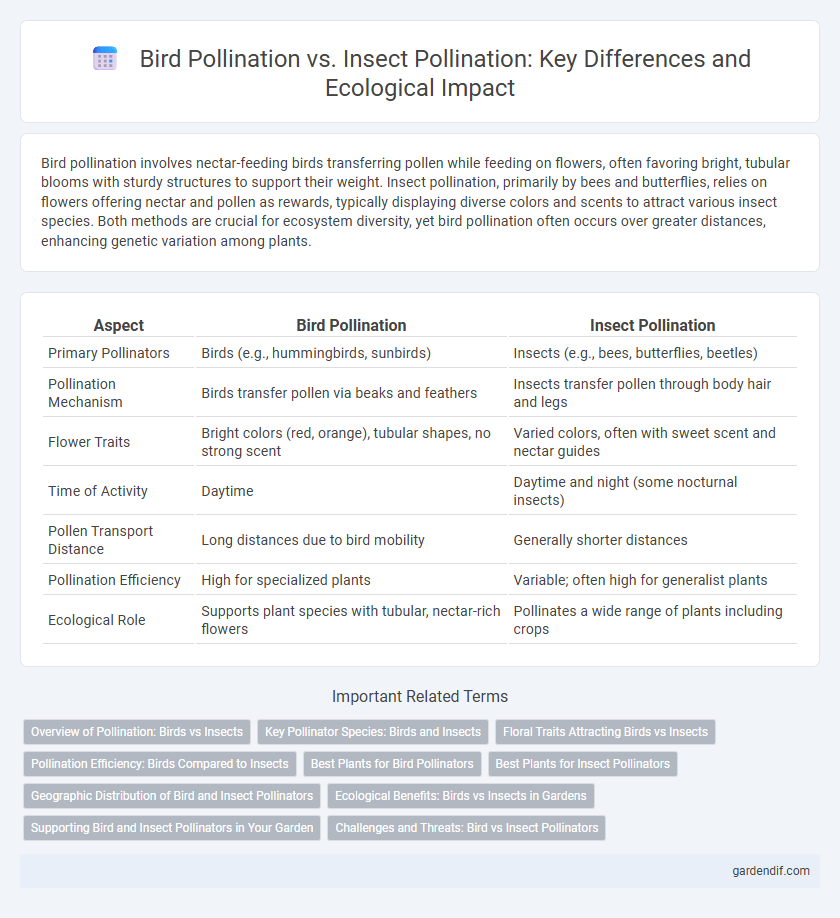
Bird Pollination vs Insect Pollination Illustration
Bird pollination involves nectar-feeding birds transferring pollen while feeding on flowers, often favoring bright, tubular blooms with sturdy structures to support their weight. Insect pollination, primarily by bees and butterflies, relies on flowers offering nectar and pollen as rewards, typically displaying diverse colors and scents to attract various insect species. Both methods are crucial for ecosystem diversity, yet bird pollination often occurs over greater distances, enhancing genetic variation among plants.
Table of Comparison
| Aspect | Bird Pollination | Insect Pollination |
|---|---|---|
| Primary Pollinators | Birds (e.g., hummingbirds, sunbirds) | Insects (e.g., bees, butterflies, beetles) |
| Pollination Mechanism | Birds transfer pollen via beaks and feathers | Insects transfer pollen through body hair and legs |
| Flower Traits | Bright colors (red, orange), tubular shapes, no strong scent | Varied colors, often with sweet scent and nectar guides |
| Time of Activity | Daytime | Daytime and night (some nocturnal insects) |
| Pollen Transport Distance | Long distances due to bird mobility | Generally shorter distances |
| Pollination Efficiency | High for specialized plants | Variable; often high for generalist plants |
| Ecological Role | Supports plant species with tubular, nectar-rich flowers | Pollinates a wide range of plants including crops |
Overview of Pollination: Birds vs Insects
Bird pollination primarily involves nectar-feeding species such as hummingbirds and sunbirds, which transfer pollen while accessing floral nectar, often targeting brightly colored, tubular flowers with abundant nectar. Insect pollination, predominantly carried out by bees, butterflies, and beetles, relies on a wide variety of flower shapes and scents to attract diverse insect species essential for effective pollen transfer. Both modes of pollination are crucial for ecosystem biodiversity, with birds favoring larger, sturdier flowers and insects supporting pollination in both small and large flowering plants.
Key Pollinator Species: Birds and Insects
Bird pollination primarily involves nectar-feeding bird species such as hummingbirds, sunbirds, and honeyeaters, which are attracted to brightly colored flowers with tubular shapes. Insect pollination is dominated by bees, butterflies, moths, beetles, and flies, each with distinct foraging behaviors that influence pollen transfer efficiency. The adaptation of flower morphology and nectar production reflects the specific needs and sensory capabilities of birds or insects, making these species crucial for the reproductive success of many angiosperms.
Floral Traits Attracting Birds vs Insects
Bird-pollinated flowers typically exhibit bright red, orange, or yellow hues and have tubular shapes to accommodate bird beaks, along with copious nectar production. Insect-pollinated flowers often display a wide range of colors, including ultraviolet patterns visible to insects, and emit specific fragrances that attract bees, butterflies, or beetles. The floral structure for insect pollination is usually smaller and more accessible, featuring landing platforms and pollen guides to facilitate insect visits.
Pollination Efficiency: Birds Compared to Insects
Bird pollination often results in higher pollination efficiency due to birds' ability to travel longer distances and visit more flowers per foraging trip, enhancing genetic diversity in plants. Unlike many insects, birds are less affected by weather conditions, ensuring more consistent pollination activity throughout the day. The larger body size of birds enables the transfer of greater quantities of pollen grains compared to most insect pollinators, boosting overall plant reproductive success.
Best Plants for Bird Pollinators
Bird pollination primarily benefits from tubular, brightly colored flowers like hibiscus, fuchsia, and trumpet vine, which provide ample nectar and accommodate bird beaks. In contrast, insect pollination often relies on smaller, fragrant flowers such as lavender, daisies, and clover that attract bees, butterflies, and other insects. Planting species like coral honeysuckle and red hot poker supports hummingbirds and other bird pollinators effectively, enhancing biodiversity and garden pollination success.
Best Plants for Insect Pollinators
Insect pollinators, including bees, butterflies, and beetles, are most attracted to flowers with bright colors such as blue, yellow, and ultraviolet patterns that guide them to nectar. Native plants like milkweed, coneflowers, and lavender provide optimal nectar and pollen resources, supporting diverse insect populations and promoting ecosystem health. Selecting plants rich in nectar and arranged in clustered blooms maximizes pollination efficiency and benefits agricultural productivity.
Geographic Distribution of Bird and Insect Pollinators
Bird pollination primarily occurs in tropical and subtropical regions, especially in the Americas, Australia, and Africa, where hummingbirds, sunbirds, and honeyeaters are prevalent. Insect pollination is more widespread globally, dominating temperate and cooler climates, with bees, butterflies, and beetles playing major roles. Geographic distribution of pollinators influences plant-pollinator co-evolution, with bird pollinators favoring brightly colored, tubular flowers in warmer areas and insect pollinators adapting to diverse floral morphologies across various environments.
Ecological Benefits: Birds vs Insects in Gardens
Bird pollination enhances garden biodiversity by attracting avian species that facilitate seed dispersal and control insect populations, promoting a balanced ecosystem. Insect pollination, particularly by bees and butterflies, ensures efficient transfer of pollen with higher flower visitation rates, boosting plant reproduction and crop yields. Both birds and insects contribute uniquely to ecological resilience, but insect pollinators often sustain a broader range of native plant species in garden habitats.
Supporting Bird and Insect Pollinators in Your Garden
Supporting bird and insect pollinators in your garden enhances biodiversity and improves plant reproductive success. Incorporate native flowering plants with varied bloom times to provide continuous nectar sources for hummingbirds and bees. Installing water sources, shelter, and avoiding pesticides creates a hospitable environment that encourages both bird and insect pollinators to thrive.
Challenges and Threats: Bird vs Insect Pollinators
Bird pollinators face challenges such as habitat loss, climate change, and competition for nectar resources, which can reduce their populations and disrupt pollination networks. Insect pollinators, including bees and butterflies, are threatened by pesticide exposure, habitat fragmentation, and diseases like colony collapse disorder. Both bird and insect pollinators experience pressures that impact plant reproduction and ecosystem stability, highlighting the need for targeted conservation strategies.
Bird Pollination vs Insect Pollination Infographic

 gardendif.com
gardendif.com